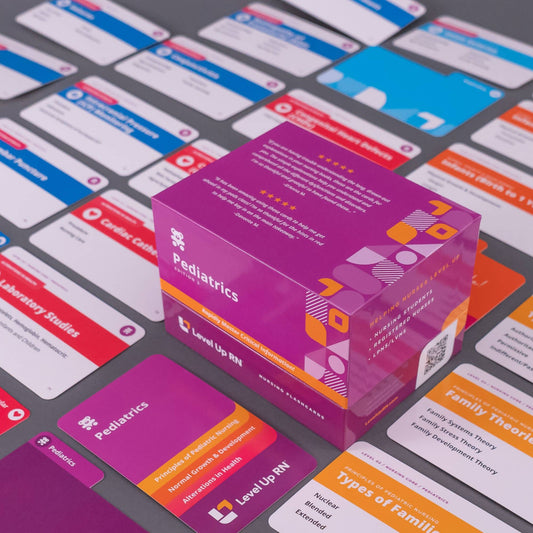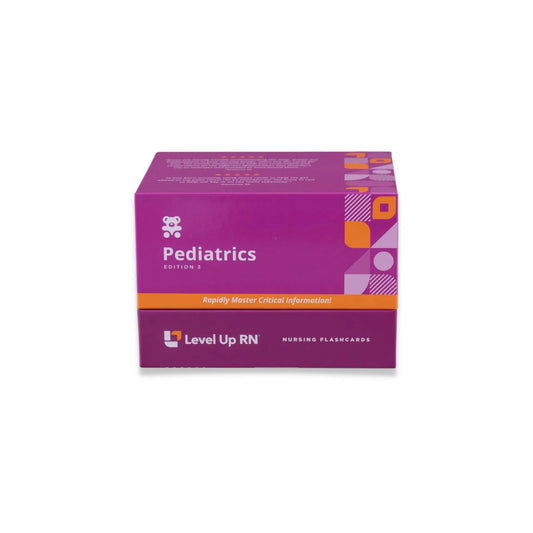Peds, part 15: Respiratory Disorders - Strep Throat, Tonsillitis
Updated: Cathy ParkesAcute streptococcal pharyngitis (strep throat), including the pathophysiology, signs/symptoms, diagnosis, treatment, and family teaching for this disorder. In addition, tonsillitis. The pathophysiology, risk factors, signs/symptoms, labs/diagnosis, and treatment of tonsillitis. In addition, nursing care for a tonsillectomy and family teaching following a tonsillectomy.
Full Transcript: Peds, part 15: Respiratory Disorders - Strep Throat, Tonsillitis
Full Transcript: Peds, part 15: Respiratory Disorders - Strep Throat, Tonsillitis
Hi, I'm Cathy with Level Up RN. In this video, we are going to continue our coverage of respiratory system disorders. Specifically, I will be talking about strep throat and tonsillitis. If you have our Level Up RN pediatric nursing flashcards, definitely pull those out so you can follow along with me. At the end of the video I'm going to give you guys a little quiz to test your knowledge of some of the key points I'll be covering in this video. So definitely stay tuned for that.
First up, let's talk about acute streptococcal pharyngitis, which is the fancy name for strep throat. So streptococcal becomes strep, and then pharyngitis means inflammation of the pharynx, which is the throat. So strep throat is a highly contagious infection that is spread through respiratory droplets and is caused by Group A beta-hemolytic streptococcus, so GABHS. Left untreated or partially treated, strep throat can cause rheumatic fever as well as acute glomerulonephritis. These are two key complications, and these are also disorders that we will be covering in more detail as part of this pediatric nursing playlist. Signs and symptoms of strep throat include a sore throat, pain with swallowing, fever, swollen and enlarged lymph nodes, so lymphadenopathy, as well as a foul breath odor, and then the tonsils may be red with white patches. We would diagnose this condition using a rapid strep throat culture, so that throat culture will be positive for GABHS. In terms of treatment, antibiotics would be used to treat the infection, and it's going to be essential that you reinforce the importance for the child to complete the entire course of antibiotics so that we don't end up with those complications, such as rheumatic fever or acute glomerulonephritis. We can also use acetaminophen or Tylenol for the sore throat and to help with fever. In terms of family teaching, we want to encourage the use of saltwater gargles, which will help the throat feel better. Also, we want to make sure the child is getting enough hydration, so ice chips as well as frozen juice pops may be helpful to get more fluid into the child. The cold will feel better on their throat. In addition, we want to make sure we are washing the child's toothbrush thoroughly or replacing it so that the child doesn't end up re-infecting themselves after they are treated for the strep throat infection.
Next up, we have tonsillitis, which is inflammation of the tonsils. Any time you see -itis, that means inflammation of whatever is ahead of that. So tonsillitis is caused by a bacterial or viral infection. School-age children are most susceptible to tonsillitis due to their exposure to germs in the school environment. Signs and symptoms include fever, sore throat, enlarged tonsils, which if they get too big, it can actually impair the airway. So that's what happened with my daughter. Her tonsils got huge, and she just wasn't breathing well at night, so we had to get them removed. In addition, you may see white patches on the tonsils as well as exudate. So in terms of diagnosis if we run labs, white blood cells will likely be elevated, and any time a patient presents with a sore throat, we're going to want to do a rapid strep culture. So to check for that GABHS or strep throat infection. In terms of treatment, we would provide antibiotics, antipyretics to help with fever. And then for patients who have chronic tonsillitis, which is something I had as a child, they will likely require a tonsillectomy, so removal of the tonsils. So in terms of nursing care for a tonsillectomy prior to the procedure, you want to assess for a family history of bleeding disorders, and you want to run labs to check for bleeding disorders. Post-operatively, you want to provide an ice collar for the patient. So that ice color will help to decrease pain and inflammation. And then you want to assess the patient carefully for frequent swallowing or clearing of the throat. If they are doing that, that is a sign of bleeding because if they have bleeding kind of running down their throat, they may be coughing or clearing their throat frequently. And bleeding is a key complication following a tonsillectomy. In terms of family teaching, when the patient goes home, you want to advise the family to not provide the child with red foods or liquids post-operatively because if the patient were to vomit, if they are consuming red foods or liquids, it's going to look like blood. So we want to be able to assess for blood in the vomit or emesis if that occurs. And we don't want to complicate things by allowing the child to consume red foods or liquids. We also want to advise our families to avoid giving the child spicy foods. They should not use straws because when they're using a straw, it kind of disrupts the suture line and can cause bleeding. In addition, we want to advise our child to avoid coughing or blowing their nose vigorously because those things can also cause excess bleeding.
All right. It's time for a quiz. Are you guys ready? I have three questions for you. First question. If left untreated, strep throat can lead to what two key disorders? The answer is rheumatic fever and acute glomerulonephritis. Question number two, frequent swallowing after a tonsillectomy may be indicative of what complication? The answer is bleeding. Question number three, following a tonsillectomy, the patient should use a straw to drink liquids. True or false? The answer is false because that can disrupt the suture line. All right. That's it for this video. I hope you enjoyed it. If so, be sure to like the video, leave me a comment, and I'll see you soon.



1 comment
Great video. I am an adult Rn, but my 8 yr old daughter enjoyed it too. Looking forward to more video.